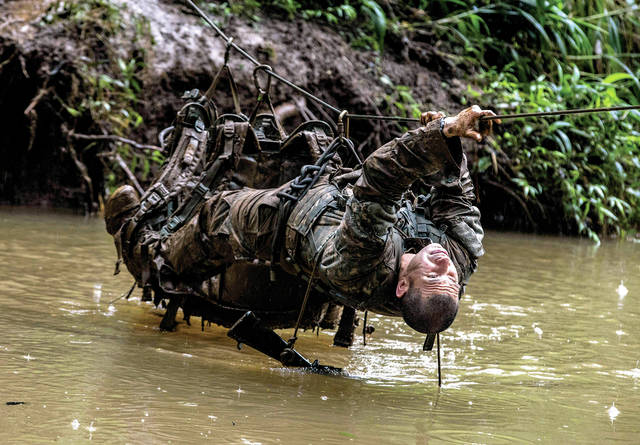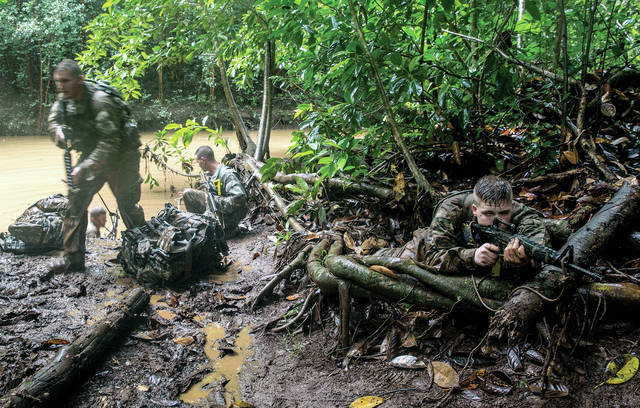HONOLULU — The U.S. Army soldiers finished wading across a stream in a rainforest in Hawaii, and they were soaked. Their boots and socks were water-logged and their clothes, hair and ears were caked with mud. ADVERTISING HONOLULU — The
HONOLULU — The U.S. Army soldiers finished wading across a stream in a rainforest in Hawaii, and they were soaked. Their boots and socks were water-logged and their clothes, hair and ears were caked with mud.
The soldiers were going through training at the first jungle school the Army has established in decades. The course is part of a program to train soldiers for exercises and potential combat on terrain that looks more like islands and nations in the Pacific than arid Afghanistan and the deserts of the Middle East.
Brig. Gen. Stephen Michael, deputy commander of the 25th Infantry Division, said the Army set up the school as its footprint was shrinking in Iraq and Afghanistan after more than a decade of war in those countries.
“The jungle school gives us that focus, it reinforces that we’re in the Pacific,” Michael said. “If you’re in the 25th, you understand you got to fight in the tough environment of the Pacific.”
Ever since the turn of the 20th century, the Army has fought in tropical rainforests. It spent years, for example, battling Filipino insurgents after the 1898 Spanish-American War. The Vietnam War was fought in the jungle.
The Army gave up its jungle training school in Panama in 1999 when the U.S. returned land there to the Panamanian government. Then jungle training lost priority in the aftermath of the Sept. 11 attacks as the Army focused on preparing soldiers to fight in Afghanistan and Iraq.
Now, surviving and fighting in tropical rainforests has captured the Army’s interest again. In 2013, it set up a jungle school at Schofield Barracks, a sprawling Army post some 30 miles west of the soft sands of Waikiki. Its dense woods have a stream soldiers can practice crossing and cliffs for rappelling.
First it needed instructors. The Army sent soldiers to military jungle schools in Brazil, Brunei and other tropical spots to reacquire long-lost skills. Instructors-in-training poured over old Army jungle manuals.
“We had to relearn everything,” said Staff Sgt. Ascencion Lopez, who was one of the first instructors at the school, which is part of the 25th Infantry Division’s Lightning Academy.
The soldiers quickly discovered their existing uniforms stood out among the trees and the fabric took too long to dry. The Army is currently developing a new uniform and boots specifically for the jungle. Instructors in Hawaii are testing out some early models.
The soldiers have also had to adjust how they carry their ammunition, canteens and other gear. In the desert, soldiers frequently strap gear on their chests so it’s accessible while riding vehicles. But instructors recommend soldiers carry gear on their sides in the jungle so it won’t get caught on roots and vines while they’re maneuvering on the forest ground.
One day recently, Lopez watched soldiers from the 1st Stryker Brigade Combat Team in Fort Wainwright, Alaska, practice using a rope and pulley to cross a stream. The soldiers were attending the course to get ready for upcoming exercises in Malaysia, Thailand and other countries in the region.
Lopez tells soldiers to keep a dry change of clothes to wear at night and to pay special attention to drying out their feet. That’s because feet won’t heal if they’re continually wet. A small cut will become infected and the skin will die.
“The minute your feet go, you’re done. You’re not going to be able to function in the jungle,” Lopez said.
Soldiers must also develop the mental stamina to persevere in a place where they’re constantly wet, thick vegetation can hide the enemy and deadly animals may be lurking. (Though soldiers are spared threatening animals in Hawaii as the state has no snakes and the only native land mammal is a small, rare bat.)
“Soldiers that aren’t as mentally tough — they’re either going to find their toughness or they won’t. But the jungle doesn’t care either way,” said Staff Sgt. Michael Johnson, another instructor.
The jungle school is an outgrowth of former President Barack Obama’s “pivot” to Asia and the Pacific. It’s still unclear whether President Donald Trump will maintain a similar emphasis.
Brian Price, a professor in diplomacy and military studies at Hawaii Pacific University, said the Army is training in the jungle so it will be ready before a crisis demands it.
“The Army has to train to fight everywhere — jungles, deserts, mountains and fair climates as well. This is kind of the missing piece of all that,” he said.




